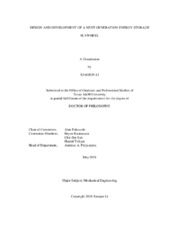| dc.description.abstract | Energy storage is crucial for both smart grids and renewable energy sources such as wind or solar, which are intermittent in nature. Compared to electrochemical batteries, flywheel energy storage systems (FESSs) offer many unique benefits such as low environmental impact, high power quality, and larger life cycles. This dissertation presents the design and development of a novel utility-scale FESS that features a shaftless, hubless rotor. The unique shaftless design gives it the potential of a doubled energy density and a compact form factor. Its energy and power capacities are 100 kWh and 100 kW, respectively. The flywheel is made of high-strength steel, which makes it much easier to manufacture, assemble, and recycle. Steels also cost much less than composite materials. In addition, the system incorporates a new combination active magnetic bearing. Its working principle and the levitation control for the flywheel are presented. The development of an integrated, coreless, permanent-magnet (PM) motor/generator for the flywheel is briefly discussed as well. Initial test results show that the magnetic bearing provides stable levitation for the 5443-kg flywheel with small current consumptions. Furthermore, this dissertation formulates and synthesizes a detailed model for designing and simulating a closed-loop control system for the proposed flywheel system at high speed. To this end, the magnetic bearing supporting structure is considered flexible and modeled by finite element modeling. The magnetic bearing is characterized experimentally by static and frequency-dependent coefficients, the latter of which are caused by eddy current effects and presents challenges to the levitation control. Sensor- runout disturbances are measured and included in the model. System nonlinearities in power amplifiers and the controller are considered as well. Even though the flywheel has a large ratio of the primary-to-transversal moment of inertias, Multi-Input-Multi-Output (MIMO) feedback control demonstrates its effectiveness in canceling gyroscopic torques and stabilize the system. Various stages of PD controllers, lead/lag compensators, and notch filters are also implemented to suppress the high-frequency sensor disturbances and structural vibrations. | en |


